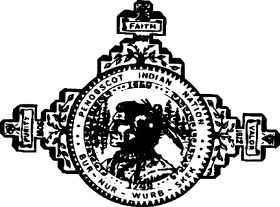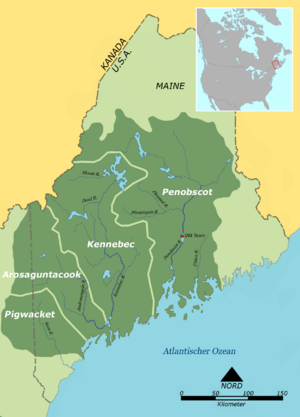Penobscot
The Penobscot (Panawahpskek) are a sovereign people indigenous to what is now Maritime Canada and the northeastern United States, particularly Maine. They were and are significant participants in the historical and present Wabanaki Confederacy, along with the Passamaquoddy, Maliseet and Mi'kmaq nations.
The word "Penobscot" originates from a mispronunciation of their name "Penawapskewi." The word means "rocky part" or "descending ledges" and originally referred to the portion of the Penobscot River between Old Town and Bangor. The tribe has adopted the name Penobscot Indian Nation.
Penobscot is also the name of the dialect of Eastern Abenaki (an Algonquian language) that the Penobscot people speak.
History
The Penobscot Indian Island Reservation is surrounded by the waters of the Penobscot River, in Penobscot County, Maine. This large river runs from their sacred mountain to the north, Mount Katahdin, down through the state to Penobscot Bay. It was along this river that they made seasonal relocations to the ocean for seafood, and then back inland for moose, deer, elk and bear hunting, as weather dictated.They lived in wigwams mostly.
Mount Katahdin remains a sacred place for these people, and as such travel to the top of the mountain is considered taboo. It is believed that an angry god resides in Pamola Peak. Pamola is a lower god in the spiritual belief system of the Penawapskewi. Pamola was an angry god, and because of his trickster behavior, was sent to Mt. Katahdin for eternity by the power of the highest god, Gluskab.
These people have a prehistoric tie to the river, such that it long ago became a part of their identity. The name of their tribe is the name of a place on the river where they spent most of their time throughout the year, a place "where the white rocks are," also identified as "where the river widens."[citation needed]
The insignia of this tribe, evidenced in their art and design, is the fiddlehead, in this case an immature frond of the Ostrich fern (Matteuccia struthiopteris L.) that grows along the banks of the Penobscot River. Fiddleheads of this fern are a delicacy and are one of the first "blooms" appearing after the harsh winters of the region, thus considered a gift from a spiritual higher power: a reward for having survived the winter.
This tribe became federally recognized through the Maine Land Claims Act, signed on March 15, 1980. Under the terms of the agreement, the Penobscot and Passamaquoddy tribes received a settlement of $81.5 million in return for relinquishing their rights to 19,500 square miles, for roughly 60% of the state of Maine.. They mostly live on a reservation at Indian Island, which is near Old Town.
Casino
In 1973, the Penobscot tribe was one of the first Native American tribes to begin gambling enterprises with the opening of Penobscot High Stakes Bingo which is located on the reservation.
Notable Penobscots
- Andrew Sockalexis, a marathon runner who competed in the 1912 Stockholm Olympics, inducted into the Maine Running Hall of Fame in 1989. [1]
- Louis Sockalexis, the first native American in major league baseball. The Cleveland Spiders became the Cleveland Indians in honor of him.
- Molly Spotted Elk, famous performer of the silent film era.
- Joseph Nicolar, Penobscot Tribal Representative to Maine State Legislature and author of 1893 book "The Life and Traditions of the Red Man."
- Charles Norman Shay, Decorated war hero of Omaha Beach, Normandy, in WWII, recipient of the French Legion of Honor medal
See also
- Abenaki
- Maine Penny
ReferencesISBN links support NWE through referral fees
- Bourque, Bruce J. 2004. Twelve Thousand Years: American Indians in Maine. Lincoln, NE: Bison Books. ISBN 0803262310
- Calloway, Colin G. (ed.). 1991. Dawnland Encounters: Indians and Europeans in Northern New England. Lebanon, NH: University Press of New England. ISBN 0874515947
- Doherty, Katherine M., and Craig A. Doherty. 1996. The Penobscot. Franklin Watts. ISBN 0531157644
- Godfrey, E. John. 1872. [The ancient Penobscot, or Panawanskek]. The Historical Magazine and Notes and Queries concerning The Antiquities, History, and Biography of America XXI(II) (February, 1872) 85-92. Retrieved October 1, 2008.
- MacDougall, Pauleena. 2004. The Penobscot Dance of Resistance: Tradition in the History of a People. New Hampshire. ISBN 1584653817
- Vetromile, Eugene. [1856] 2008. Indian Good Book - For The Benefit Of The Penobscot, Passamaquoddy, St. John's, Micmac, And Other Tribes Of The Abnaki Indians. Read Books. ISBN 978-1408614785
- Waldman, Carl. 2006. Encyclopedia of Native American Tribes. New York, NY: Checkmark Books. ISBN 978-0816062744
External links
- Official Website of the Penawapskewi
- "The Ancient Penobscot, or Panawanskek." Historical Magazine, February, 1872.
- Maine Land Claim Maine Indian Tribal-State Commission, Hallowell, Maine, February 14, 1995.
- Asticou's Island Domain: Wabanaki Peoples at Mount Desert Island 1500–2000 National Park Service.
Credits
New World Encyclopedia writers and editors rewrote and completed the Wikipedia article in accordance with New World Encyclopedia standards. This article abides by terms of the Creative Commons CC-by-sa 3.0 License (CC-by-sa), which may be used and disseminated with proper attribution. Credit is due under the terms of this license that can reference both the New World Encyclopedia contributors and the selfless volunteer contributors of the Wikimedia Foundation. To cite this article click here for a list of acceptable citing formats.The history of earlier contributions by wikipedians is accessible to researchers here:
The history of this article since it was imported to New World Encyclopedia:
Note: Some restrictions may apply to use of individual images which are separately licensed.

